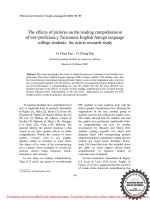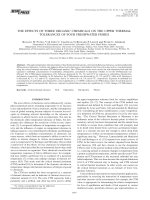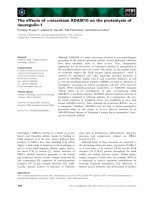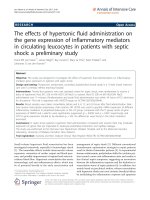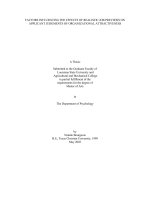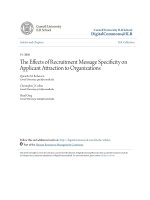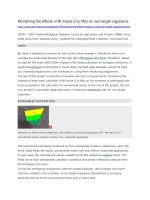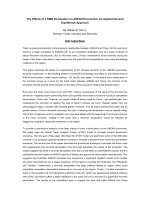The effects of guidee extensive reading on efl students reading comprehension and motivation an action research study at class k50a5, national economics university
Bạn đang xem bản rút gọn của tài liệu. Xem và tải ngay bản đầy đủ của tài liệu tại đây (12.57 MB, 116 trang )
mwm
000042479
MINISTRY OF EDUCATION AND TRAINING
HANOI UNIVERSITY
Ĩ8UMG
ĨKÕNG TIN THÚTVtỆr
NN-VH NIỈỚC fj&OAl
T4TV
____
NGUYEN THI THANH
THE EFFECTS OF GUIDED EXTENSIVE READING ON
EFL STUDENTS’ READING COMPREHENSION AND
MOTIVATION: AN ACTION RESEARCH STUDY AT
CLASS K50A5, NATIONAL ECONOMICS UNIVERSITY.
SUBMITTED IN PARTIAL FULFILMENT OF THE REQUIREMENTS
FOR THE DEGREE OF MASTER IN TESOL.
SUPERVISOR: NGUYEN DUC HOAT, Ph.D
Hanoi
December, 2009
S T A T E M E N T O F A U T H O R S H IP
I certify that the thesis entitled “The effects o f guided extensive reading on
EFL students’ reading comprehension and motivation: An action research
study at class K50A5, National Economics University ” submitted in partial
fulfillment o f the requirements for the degree o f Master o f Arts in TESOL is
the results of my work, except where otherwise acknowledged, and that this
thesis or any part o f the same has not been submitted for a higher degree to any
other university or institution.
The research reported in this thesis was approved by Hanoi University.
Signed:
Dated:
ACKNOWLEDGEMENTS
I am most grateful to my supervisor, Dr. Nguyen Due Hoat, for his great
assistance, encouragement, enthusiasm and valuable comments, which have
played a very important role during the course of writing this thesis. Without
his precious support and invaluable guidance, this thesis would never have
been completed.
I would like to take this opportunity to express my special thanks to Mrs.
Nguyen Thai Ha (MA) from the Department o f Post Graduate Studies of Hanoi
University for her interesting and informative lecturers prior the information of
the idea for this study as well as her later valuable guidance, encouragement
and advice during the implementation of the study.
I also would like to send my thanks to all the lecturers from the Department of
Post Graduate Studies o f Hanoi University who have provided me with
invaluable sources of knowledge and instructions during my study at Hanoi
University.
I would wish to thank my colleagues and my students o f National Economics
University for their willingness to participate in this study. Without their help,
this project could not have been so successful.
Finally, my sincere thanks also go to my family and friends whose support has
been o f great significance to the success o f my thesis.
ABSTRACT
As non-native speakers of English, Vietnamese students in general and the
students at NEU in particular meet a great number o f difficulties in reading
comprehension
and
motivation.
In
an
attempt
to
improve
reading
comprehension and motivation for the second-year non-English major students,
the researcher decided to carry out an action plan with 32 students of class
K50A5, NEU.
A Pre-Test and Survey-Questionnaire were used before the action to identify
the level o f students’ reading comprehension, students’ background knowledge,
students’ computer and Internet skills as well as their attitudes towards being
asked to involve in Extensive reading program (ERP). An action research was
planned and implemented in six weeks to help students overcome major
problems in reading as well as achieve other skills through the program. The
Post-Test and Post-Action Questionnaire were used to study the possible
changes in the students’ reading comprehension and motivation as well as other
skills after the action.
The result o f the study revealed that the program had positive effects on
students’ reading comprehension and motivation. Moreover, through the
program, most students indicated that they improved speaking, writing skills as
well as computer and Internet skills. Besides, most o f them agreed that they
improved reading speed as well as created reading habits in their free time.
It is hoped that the study will be able to serve as a reference as well as provide
useful information for other English teachers at NEU as well as other
researchers who want to conduct researches on extensive reading (ER) in the
future.
ii
TABLE OF CONTENT
S T A T E M E N T O F A U T H O R S H I P .............................................................................................................. I
A C K N O W L E D G E M E N T S ............................................................................................................................ I
A B S T R A C T ............................................................................................................................................................II
T A B L E O F C O N T E N T ...................................................................................................................................Hi
LIST O F F IG U R E S ..........................................................................................................................................VI
LIST O F T A B L E S ...........................................................................................................................................VII
LIST O F A B B R E V I A T I O N S ................................................................................................................... VIII
C H A P T E R I: IN T R O D U C T I O N ................................................................................................................... 1
1.1. BACKGROUND TO THE S T U D Y ............................................................................................. 1
1.1.1. Practical background......................................................................................................... 1
1.1.2. Theoretical background........................................................................................................2
1.2. THE AIMS OF THE ST U D Y ....................................................................................................... 3
1.3. SIGNIFICANCE AND SCOPE OF THE S T U D Y ....................................................................3
1.4. OUTLINE OF THE THESIS......................................................................................................... 3
C H A P T E R II: L IT E R A T U R E R E V IE W ...................................................................................................5
2.1. READING AND READING CO M PREH ENSION ................................................................. 5
2.1.1. Overview o f reading and reading comprehension...........................................................5
2.1.2. The importance o f reading fo r non-English-speaking students.................................... 5
2.1.3. Factors affecting the development o f learners ’ reading ability.................................... 6
2.2. EXTENSIVE RE A D IN G .............................................................................................................10
2.2.1. Definition o f extensive reading...................................................................................... 10
2.2.2. Roles o f extensive reading in language learning.........................................................10
2.2.3. Materials used fo r extensive reading............................................................................ I /
2.2.4 Major characteristics o f an extensive reading program ............................................. 12
2.2.5. Top ten principles fo r an extensive reading program ................................................ 13
2.2.6. Instruments used to monitor students ’ reading in an extensive reading program. 16
2.3. THE INTERNET........................................................................................................................ 16
2.3.1. Reasons fo r using the Internet in the EFL c la ss......................................................... 16
2.3.2. The benefits o f Internet in teaching and learning.......................................................17
2.3.3. The Internet as a source o f extensive reading materials............................................/ 7
2.3.4. Advantages and disadvantages o f web-based materials............................................18
2.4. M O TIV A TIO N ............................................................................................................................. 20
2.4.1. Definition o f M otivation.................................................................................................... 20
2.4.2. The role o f motivation in second language learning ....................................................20
2.4.3. Factors affecting students' motivation in learning reading......................................... 2 1
2.5. PREVIOUS STUDIES ON ER IN E F L ................................................................................. .24
C H A P T E R 3: M E T H O D O L O G Y .................................................................................................... . 2 6
3.1. REASEARCH Q U E ST IO N S.................................................................................................. .26
3.2. PARTICIPANTS....................................................................................................................... .26
3.3. S E T T IN G ................................................................................................................................... .27
3.4. RESEARCH DESIGN.............................................................................................................. .27
3.4.1. Definition o f Action research......................................................................................... 27
3.4.2. Advantages, disadvantages o f AR and rationale fo r using A R ............................... 28
3.4.3. Action research procedures........................................................................................... 29
3.4.4. Data collection instruments........................................................................................... 36
3.5. S U M M A R Y ............................................................................................................................... .40
C H A P T E R 4: RESU LTS AND D ISCUSSION.............................................................................. 41
4.1. INITIAL D A T A ........................................................................................................................ 41
4.1.1. Results o f the Pre-Test.................................................................................................... 41
4.1.2. Results o f Survey Q uestionnaires................................................................................. 41
4.1.3. Findings fro m the initial data........................................................................................ 47
4.2. ACTION D A T A ........................................................................................................................ 47
4.2.1. Students' problem s and concerns.................................................................................. 48
4.2.2. Students' changes............................................................................................................. 52
4.2.3. Findings fro m action data............................................................................................... 57
4.3. POST-DATA.............................................................................................................................. 58
4.3.1 Data collectedfrom Post-Test......................................................................................... 58
4.3.2. Data collected fro m Post-Act ion Questionnaires........................................................ 58
4.3.3. Findings fro m p o st-d a ta .................................................................................................. 62
4.4. EVALUATION OF THE ACTION PLAN............................................................................ 62
4.4.1. Positive effects o f online business news extensive reading program on students ’
reading comprehension............................................................................................................................ 62
4.4.2. Positive effects o f online business news extensive reading program on students ’
motivation................................................................................................................................................... 64
4.4.3. Other findings fro m the program ................................................................................... 64
4.5. S U M M A R Y ................................................................................................................................ 65
C H A P T E R 5: R E C O M M E N D A T IO N S AND C O N C L U S I O N .............................................. 67
5.1. R E C O M M EN DA TIO N S......................................................................................................... 67
5 .1.1. Recommendations fo r teachers...................................................................................... 67
5.1.2. Recommendations fo r students...................................................................................... 69
5.1.3. Recommendations fo r N E U ............................................................................................ 69
5.2. LIMITATIONS OF THE STUD Y ........................................................................................... 70
5.3. CON CLUSION S........................................................................................................................ 70
R E F E R E N C E S ................................................................................................................................................... 73
A P P E N D I C E S ...................................................................................................................................................... 81
APPENDIX 1: THE PRE-TEST AND POST-TEST...................................................................... 81
APPENDIX 2: SURVEY Q U ESTIONNAIRES............................................................................ 90
APPENDIX 3: PHIẾU ĐIỀU TRA KHAO S Á T .............................................................................92
APPENDIX 4: POST-ACTION QUESTIONNAIRES.................................................................. 94
APPENDIX 5: CÂU HỎI ĐIỀU TRA SAU CHƯƠNG T R Ì N H ................................................. 96
APPENDIX 6: LIST OF RECOMMENDED BUSINESS W E B SIT E S..................................... 98
APPENDIX 7: A SAMPLE OF EXTENSIVE READING............................................................99
APPENDIX 8: EXTENSIVE READING WORKSHEET............................................................101
APPENDIX 9: PRE-TEST AND POST-TEST RESULTS.................................................................105
V
LIST OF FIGURES
Figure 3.1: Simple Action Research Model (from Maclsaac, 1995)'1"1
Figure 3.2: Detailed Action Research Model (adapted from Susman 1983)1[in|
Figure 3.3: Action Research Cycle (Somekh in Me Bride & Sckostak, 1989)
Figure 4.1: The length o f time o f learning English before entering NEU
Figure 4.2: Students’ opinions on the time for reading in class
Figure 4.3: Students’ opinion on the number o f readings in Powerbase
Elementary and Pre-Intermediate
Figure 4.4: Students’ needs o f having readings to read outside class to improve
reading comprehension
Figure 4.5: Students’ opinion on the person finding readings
Figure 4.6: Students’ opinions on the topics o f readings
Figure 4.7: Students’ attitude towards being asked to read English news online
Figure 4.8: Students’ experience in sending and receiving attacked files
through e-mail
Figure 4.9: Students’ reading speed
Figure 4.10: Students’ self-rate o f reading comprehension
Figure 4.11: Students’ opinion on the level o f difficulty o f the news
Figure 4.12: Students’ attitudes toward reading the news
Figure 4.13: The difference between mean scores o f Pre-Test and Post-Test
LIST OF TABLES
Table 4.1 : Results of the Pre-test
Table 4.2: Selecting news
Table 4.3: Checking summary
Table 4.4: Using dictionary
Table 4.5: Results of the Post-test
Table 4.6: Post-Action Questionnaires
Table 4.7: Comparison o f Pre-Test and Post-Test results
LIST O F A B B R E V IA T IO N S
AR: Action Research
ER: Extensive reading
ERP: Extensive Reading Program
ELT: English Language Teaching
EFL: English as a Foreign Language
ESL: English as a Second Language
ERW: Extensive Reading Worksheet
L I : First language
L2: Second language
NEU: National Economics University
RC: Reading comprehension
SPSS: Statistical Package for the Social Sciences
SD: Standard Deviation
W: Week
N:News
C H A P T E R I: IN TR O D U C T IO N
This first chapter presents the background to the study, the aims of the study,
the research questions, the scope and significance of the study as well as the
outline o f the thesis.
1.1. BACKGROUND TO THE STUDY
1.1.1. Practical background
Among the four macro-skills, reading is “by far the most important skill,
particularly in English as Second Language (ESL) or English as Foreign
Language (EFL)” (Carrel, 1981, p.l). For many students, reading not only
brings them a lot of interesting information but also provides a variety of
linguistic expressions as well as grammatical structures, which are very useful
for them to develop other skills. Thanks to reading, students can “gain access to
the required knowledge that is available in English” (Munby, 1978, p.3.).
At NEU, students are trained according to certificates with focus on listening,
reading skills. Right after entering the university, students were asked to take
the replacement test. According to the results o f the replacement tests, students
were divided into two different groups: group A and group B. Students got A
level in the replacement test could sign different class for A level as well as
group B. Every term, students are asked to take one mid-term paper reading
test, one mid-term paper listening test and a final computer-based multiple
choice grammar and vocabulary test.
There were 32 second-year non-English major students in class K50A5. All o f
them got A level in the replacement test. In the first year at NEU, they studied
English with the course book Powerbase - Elementary by David Evans in 120
periods. Powerbase is a communicative course book that has been specially
written for adults who need English for work, travel and everyday situations
with the two main skills: Listening and Reading. However, many students at
1
class K50A5 complaint that this course book did not give them enough
readings to read as well as the time spending on reading in class was limited.
Moreover, by discussing with students at the first meet, the researcher found
out that 50% students got scores 3, 4, 5 for reading tests in the second mid-term
reading test in the first year at NEU and 70% students felt frighten at reading
examination. It seemed that the biggest problems faced students at class K50A5
were low reading comprehension and motivation. Therefore, the teacher’s
objective here is to find the way to help students improve reading
comprehension (RC) and motivation.
1.1.2. Theoretical background
In finding ways to help students improve RC and motivation, the researcher
came across with the notion "extensive reading" (ER). By deeply read about
extensive reading, the researcher found out that ER gave considerable benefits
for learners. Hafiz and Tudor (1989) stated that ER could help students
improve reading, writing, speaking, and vocabulary. ER could lead to students’
improvement in the areas of reading, writing, vocabulary learning, and overall
proficiency while also increasing motivation (Day & Bamford, 1998). Nutall
(1982) also stated that an ER program was the single most effective way of
improving both vocabulary and reading skill, ER also provided input for
speaking and writing skills and it could be the second best way to improve
knowledge o f a foreign language. Besides, Mason & Krashen (1997) reported
that reading extensively increased motivation to read, created a good habit of
reading and developed a positive attitude toward reading.
It seemed that ER could be the best solution for students at class K50A5
because ER could help students overcome the limitations o f the course book
Powerbase as it provided more readings for students to read. It also helped
students overcome the problems of limited time on reading in class as students
could read at home. Moreover, it was considered as one of the best solutions to
improve students' RC and motivation in many countries. Inspired by the
2
benefits of extensive reading, the researcher conducted a study on the effects of
ER on students' RC and motivation by way of action research. Through this
small scale research, the researcher hopes that ER will help students at class
K50A5, NEU improve RC and motivation.
1.2. THE AIMS OF THE STUDY
The study aims:
- to investigate the problems and concerns in ER of students at class K50A5,
NEU.
- to study the possible changes in the students’ RC and motivation through the
action program.
1.3. SIGNIFICANCE AND SCOPE OF THE STUDY
As mentioned above in the “Background to the study”, RC is very important to
the students at the NEU. Therefore, helping students to improve their RC and
motivation is very helpful.
ER has been proved to bring many effects on students' RC and motivation and
other countries by different researchers whereas no similar program was
conducted in NEU with non-English major students. This fact encourages me
to conduct this research study.
It is hoped that the findings o f the study will provide convincing information
about the ways to run extensive reading program (ERP), the value o f using ER
on EFL, ESL students as well as better understanding about action research.
However, due to the limit o f time and conditions (the study was carried out
only in one class in only 6 weeks), the results of the study might be able to be
applicable to research class only.
1.4. OUTLINE OF THE THESIS.
The study will consist of five chapters:
3
-
Chapter I: “Introduction ” deals with back ground information of the study,
the aims of the study, the research questions, significant and scope o f the study
and outline o f the thesis.
-
Chapter II: “Literature review”-, concerns with an overview literature of
reading and RC, extensive reading, the Internet, and motivation.
-
Chapter III: “Methodology ” will provide the readers with definition of action
research, procedures of action research, detailed description of the participants
and data collection instruments.
-
Chapter IV: “Results and discussions ” will present results o f the study. It also
provides discussion about the results.
-
Chapter V: “Conclusion and recommendations ” is expected to provide final
conclusion o f the study, the limitations o f the study as well as suggestions for
further study.
4
C H A P T E R II: L IT E R A T U R E R E V IE W
2.1. READING AND READING COM PREHENSION
2.1.1. Overview of reading and reading comprehension
Reading might be understood as being able to identify or to decode written
words, reading behavior generally involves an understanding o f what is read.
We read because we want to get something from the writing which we call
message.
Among reading skills, RC is an important part in teaching and learning a
foreign language in general and teaching and learning reading in particular. RC
can be defined in different ways by different researchers
Richards et al. (1992) stated that RC is best described as an understanding
between the author and the reader. Lee and Vanpatten (1995, p. 191) stated that
...RC, by definition, is the process o f relating new or incoming
information to information already stored in memory. Readers
make connections between the new information on the printed
page and their existing knowledge. They must allow the new
information to enter and become part o f their knowledge store”.
Davies and Whitney (1979) considered RC as the process o f decoding language
to thought or working out the meaning o f a reading.
RC can be defined in different ways however in this study, RC is meant when
reader can get out o f the text the message the writer put into it.
2.1.2. The importance of reading for non-English-speaking students
Reading may be an all-important language skill that is now in more demand
than in any time in our history. We read everyday for information or for the
satisfaction o f knowledge. In a society that places increasing emphasis on the
importance of information and communication, reading skills are essential not
5
only for students’ academic success but also for their social and business
advancement. Pham (2005) (cited in Hoang et al., 2005) noted that reading
offered students to improve other language skills like speaking, listening,
writing. By reading, students got familiar with a number o f topics therefore
when they listened to well-read topics they became familiarized with related
words and dealt with it without much difficulty. Consequently, students would
become more confident about the topics in the text; they could speak
confidently and write well. Hoang et al. (2006) even considered reading as the
most effective means o f improving students’ language competence. In short,
reading comprehension is an essential skill that helps language learners become
successful in learning as Byrne (1988) believes "reading gives the students as
skill which they can use their own".
2.1.3. Factors affecting the development of learners’ reading ability.
2.1.3.1. Strategies
The impacts o f strategy used on foreign and second language learning have
heen consistently discussed and implied in language learning. For instant,
Ehrman and Oxford (1990, p.312) argued that strategies were able to help
second language learners to "enhance the acquisition, storage, retention, recall,
and use o f new information" Moreover, when discussing about the methods of
applying strategies in class, Nam and Oxford (1998, p.53) stated that
“unsuccessful language learners do not necessarily use fewer learning
strategies than their more successful peers; rather they simply employ strategies
in a haphazard fashion . In other words, it is the manner o f how strategies are
used that determines and differentiates of how many strategies are chosen.
From this perspective, any positive effects that strategies can exercise o f
facilitating language learning outcomes must be based on an assumed premise.
Learners have to be capable of choosing a series o f strategies that can
appropriately meet particular requirements in various contexts. On the basis of
this understanding, it is hypothesized that the effectiveness of using one
particular strategy may be related to what and how other follow-up strategies
6
are employed. In other words, the use of various strategies must be logically
connected in such a sense that all initiated strategies can either effectively solve
reading difficulties encountered or efficiently facilitate the process of reading
comprehension. Strategies mostly used in ESL/EFL might include: predicting,
scanning, skimming, analyzing, differencing, analyzing, information transfer,
brainstorming, semantic mapping.
2.1.3.2. Materials
According to White (1988), “materials” was considered to be one of the key
elements in the model o f language teaching and learning. Besides, O ’malley
and Chammot (1990, p.210) stated that
“ ...the objectives of materials are to develop academic English
language skills through content-based instruction, to develop
understanding and skills in content areas and to teach students
learning strategies that will help them become autonomous
learners o f both language and content”.
Among materials used for reading, authentic texts are considered the most
valuable materials for low level students because “classroom work in
referenced against the type o f language which learners will encounter outside
classroom” Nunan (1991, p. 16). Sharing the same idea, Grellet (1981) agreed
that “it is important to use authentic texts whenever possible”.
Authentic texts can be presented in a linear fashion in traditional print or in
nonlinear in semantic network in modem print (hypertext) where multiple
related sections o f the text are connected to each other. The reader can engage
with the text through links from the websites. The reader can choose the most
relevant texts to his needs and interests. Hypertext provides easy access to
multiple cross-references on related topics across several documents, or
screens. By following different links online, students can develop strategies to
approach text content. Reading hypertext is a naturally dynamic and integrated
process as students have opportunities to acquire, test and reframe knowledge
7
Activities that are intrinsically motivating also carry other significant
advantages such as personal satisfaction, challenge, relevance, and promotion
of a positive perspective on lifelong learning (Keller & Suzuki, 1988; Kinzie,
1990). Among the activities used in teaching and learning English, the
activities on the Internet were the best as they provided contexts for the
learners which are challenging and stimulate curiosity (Malone, 1981).
2.1.3.5. Backgro und knowledge
Background knowledge is considered one of the key factors o f RC process. It is
easier to read a text which learners know something about the topic or the topic
is familiar to them. In terms of background knowledge, first language (LI)
abilities might exert another kind o f influence on second language (L2) RC.
Individual and experiential differences refer to resources and experiences that
influence L2 RC including learners' proficiency level in L2 literacy, their
personal experiences with and motivation for L 1 and L2 reading, their attitudes
towards authentic texts, and their trainings in the use o f various supporting
resources. L2 readers are not likely to be exposed to the full range of texts to
which they are exposed in L I in terms o f length and complexity o f language
used in the texts. L2 readers often use bilingual and learner dictionaries while
reading. They also may write out translations in the L I. They may access
cultural knowledge from LI to help them.
By doing exercise as well as reading extensively, students are exposed to a
wider range o f texts than what is provided in their textbooks. Moreover,
students are provided with more reading extracted from authentic resources.
Authentic resources could be downloaded unrestrictedly in any topics with real
figures and beautiful graphics from the Internet. By linking what they are
reading with what we know about that aspect, students can understand the
reading easily and clearly. Therefore, students will be exposed to the target
language in a natural way, at the same time practicing the target patterns while
they are not just limited to information provided in the textbook.
9
through cognitive reconstruction of text. Therefore, hypertext may promote
comprehension through the elaboration and integration o f new information into
the existing knowledge network as readers create and expand the cognitive map
that guides their construction of meaning.
2.1.3.3. Feedback
Feedback is essential to language learning because students need to know
whether their conclusions about the target language are right or wrong.
Lightbown
& Spada (1990)
indicate that
learners provided
feedback
outperform those given minimal or no feedback. Van Dusen & Worther, (1995,
p.30) stated that learners also remain more engaged longer on computer tasks
with immediate feedback”. Besides, Goldenburg (1984) stated that the more
immediate that feedback is the better comprehension students are as students
can both correct their mistakes immediately and keep using the language that
they have master. Moreover, learners who receive explicit feedback were
shown to perform better than who were given implicit feedback (Carrill &
Swain, 1993).
2.1.3.4. Motivation
Motivation is a significant variable in reading. People are more motivated to
read if they are interested in the topic. The highly motivated learners
demonstrated better results in language learning. (Gardner & MacIntyre, 1991)
argued that both integrative motivation and instrumental motivation facilitated
learning. It means that when L2 learners are highly and appropriately motivated
to accomplish a language learning task, they become more active in exerting
cognitive and met cognitive efforts, more determined for maintaining their
efforts, and more cautions about their current levels of achievements as a result,
they tend to use more strategies to assure the occurrences o f their anticipated
learning outcomes.
To help students motivate, Grellet (1992, p.9) noted that “activities should be
flexible and varied” because some of them are “intrinsically good or bad” .
8
2.1.3.6. Practice
It is written in an English website when the researchers were searching the
materials for the students' practice class that the only way for ESL and EFL
students to improve their reading skills is through practice because practice
makes perfect. By practicing reading, learners will familiar with vocabularies
and topics before reading it. Teacher can ask students to do follow-up activities
like summarizing the text, giving opinion to reflect the content o f the reading.
Another way to let students practice reading is by giving them a topic and
asking them to search for it from the World Wide Web.
2.2. EXTENSIVE READING
2.2.1. Definition of extensive reading.
A lot o f trials have been made on working out a through definition of ER.
Concentrating on teaching and learning methods, Munby (1979) saw ER as just
another sub-skills such as skimming or scanning, Bamford and Day (1997)
defined ER as an approach to foreign language teaching in general, and to the
teaching o f foreign language reading in particular whereas Day and Bamford
(1998, p.viii) defined ER in a second language as “an approach to the teaching
and learning o f second language reading in which learners read large quantities
of books and other materials that are well within their linguistic competence” .
In order to give an overall picture o f ER, Robb and Susser (1989, p.3) defined
ER as a language teaching/learning procedure because it was reading “(a) o f
large quantities o f material or long text; (b) for global or general understanding;
(c) with the intention o f obtaining pleasure from the text; (d) individualized,
with students choosing the books they want to read; (e) the books are not
discussed in class” .
2.2.2. Roles of extensive reading in language learning.
The roles of ER can be seen in the following aspects:
10
ER as comprehensible input: In his book, Krashen (1982) argued that “ER will
lead to language acquisition if such certain preconditions as adequate exposure
to the language, interesting material, and a relaxed, tension-free learning
environment are met”.
ER as language competence enhancement: Grabe (1991) emphasized the
importance o f ER in providing learners with practice in automatic of word
recognition and decoding the symbols on the printed page.
ER and knowledge of vocabulary: Nagy, Anderson and Herman (1987)
claimed that children between grades three and twelve learnt up to 3000 words
a year. It was thought that only a small percentage of such learning was due to
direct vocabulary instruction, the remainder was due to acquisition of words
from reading.
ER and writing: Hafiz & Tudor (1989) studied the second language learning in
the UK and Pakistan; Robb and Susser (1989) studied the second language
learning in Japan. All o f them concluded that ER reveals more significant
improvement in students’ written work than in other language skills.
ER and learners’ motivation to read: Bell & Campbell (1997) explored the
issue in South East Asian context and came to conclusion that ER motivated
learners to read and advanced the reading habit.
2.2.3. Materials used for extensive reading
Materials plays important role in reading. Day and Bamford (1998) stated that
getting students to read extensively depended on what they read. The reading
materials must be both easy and interesting. “Easy” means materials with
vocabulary and grammar well within the students’ linguistic competence.
“Interesting” means students are familiar with the topics and are interested in
the readings. Among the available materials, authentic materials or simplified
texts written for non-native speakers are used as they provide favorable
conditions lor language learning. Nunan (1991) stated that most everyday
11
objects in the target language could be qualified as authentic materials. The
source of authentic materials could be newspapers, TV programs, menus,
magazines, movies, songs, brochures, comics,...and the Internet (Martinez,
2002 ).
2.2.4 Major characteristics of an extensive reading program.
2.2.4.1. Large quantity
Large quantities are essential for this procedure to be “extensive” but there is
no agreement on how much ‘extensive” is. Different authors have different
views on it. Firstly, the large quantities can be counted by pages. The number
of pages can be counted as thirty pages an hour (Hill and Thomas, 1988), three
pages an hour (Matsumura, 1987 cited in Susser and Robb, 1990), one page per
day and three pages per day during summer vacation (Matsumura, 1987, cited
in Susser and Robb, 1990). Secondly, the quantity can be counted by hours
spending on reading. It can be an hour per evening, (Krashen, 1981, cited in
Susser and Robb, 1990), five hours by a specified date (Bowen, Madsen, 1981,
citcd in Susser and Robb, 1990), sixty hours over three months (Hafiz and
Tudor, 1989), an hour o f ER for every hour o f intensive reading (Williams,
1986), thirty minutes per day for five stories, poems, or essays (Dalle, 1988,
cited in Susser and Robb, 1990). Thirdly, the quantity can be counted by reader
or book as one reader per week (Stoller, 1986, cited in Susser and Robb, 1990),
at least two books a week (Carroll, 1972, cited in Susser and Robb, 1990), a
minimum o f 36 simplified readers per year (Hill, 1983, cited in Susser and
Robb, 1990), 60 books a year (Bright & McGregor, 1970, cited in Susser and
Robb, 1990). In short, the quantity of readings is not an absolute number of
hours, pages, readers or books but depends on the type and purpose of the
program, the participants and other variables.
2.2.4.2. General comprehension
In reading extensively, it is not necessary to comprehend 100% the content of
the reading. On the contrary, they should simply read for general, overall
12
understanding.
This means that they should be able to follow the general
storyline and grasp the main ideas of the text. In ER, the aim is to read a great
many books, so it is in the learners' best interest not to struggle over every
detail and worry about the exact meaning of every word or phrase. By aiming
at general comprehension, this procedure reduces both teacher demands on the
students and students' demands on the texts to obtain the objectives of fluency
and speed as well as comprehension. Broughton et al., (1978, cited in Susser
and Robb, 1990) stated that “ER must imply a relatively low degree of
understanding, which must be taken in context”. Students are wished to achieve
a degree o f understanding sufficient for pleasure reading. If students find the
book too difficult to enjoy, the ER procedure requires that the book be changed
and not that the students be made to study it more closely. The level of global
understanding required varies with the students’ language proficiency, the
nature o f the text and other factors.
2.2.4.3. Pleasure reading
For pleasure, Nell (1988), in his interesting study o f the psychology of reading
for pleasure, argued that “one could not read for pleasure in a foreign language
before mastering it” This means that students need to practice reading and gain
pleasure from that practice. Moreover, students will enjoy reading texts that
they have chosen on topics o f interest. If they have chosen correctly, the texts
should be easy to read for general understanding and students can gain pleasure
from reading these texts.
Further, even students who have far from fluent
derive pleasure from the experience o f reading a book in a foreign language.
Students in ER courses regularly comment on their joy at having finished
whole books in the target language.
2.2.5. Top ten principles for an extensive reading program
Day and Bamford (1998, p.7-8) and Day and Bamford (2002) provided the
following ten top principles o f an ERP:
13
- The reading material is easy. The benefits of ER come from students. So we
have to get our students reading. One way to get them read a lot is to make sure
that they read material that contains vocabulary and grammar within their
linguistic competence. In addition, reading easy material helps the effective
dimension o f learning to read. The students discover that they can read foreign
language material, and as they read more and more material, they see
themselves as readers in the target language.
- There must be a wide variety o f materials on a wide range o f topics. Having
variety allow students to find materials they want to read. Different kinds of
reading materials also encourage a flexible approach to reading. Students learn
to read for different reasons (e.g., entertainment, information, passing time) and
in different ways (skimming, scanning, more careful reading).
- Students select what they want to read. The principle o f freedom o f choice
means that students can select texts as they read, that is, they can choose texts
they expect to understand, to enjoy or to learn from.
- Students read as much as possible, in class and out o f class. This is the
“extensive” o f ER, made possible by the previous principles. The most critical
element in learning to read is the amount o f time spent actually reading. While
most reading teachers agree with this, it may be the case that their students are
not being given the opportunity or incentive to read, read, and read some more.
There is no upper limit to the amount o f reading that can be done.
- The purpose o f reading are usually related to pleasure, information, and
general understanding and are determined by the nature o f the material and
the interest o f the students. Students are encouraged to read for a variety of
real-world reading purposes from entertainment to finding specific information.
Also in common with real-world reading, 100% comprehension is not usually
the goal. Only sufficient understanding to achieve one’s purpose is required.
14

